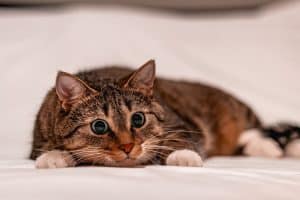Have you ever noticed that when cats are sedated, their eyes remain open? It’s a curious phenomenon that many cat owners have observed. But why does it happen?
The Physiology Behind Cat Eyes
Have you ever noticed that when cats are sedated, their eyes remain wide open? It might seem strange, but there’s a fascinating reason behind this phenomenon. The unique anatomy of cat eyes plays a crucial role in their ability to keep their eyes open even when under sedation.
Unlike humans, cats have a specialized muscle called the retractor bulbi muscle that allows them to keep their eyes open without effort. This muscle is responsible for retracting the eyeball within the eye socket, keeping the eyes in a fixed position. So, even when a cat is sedated and relaxed, their eyes stay open due to this unique muscle structure.
This adaptive feature is essential for cats in the wild, as it enables them to stay alert and aware of their surroundings, even when they are in a vulnerable state. So, the next time you see a sedated cat with its eyes wide open, remember that it’s all thanks to the incredible physiology of feline eyes.
Common Misconceptions About Sedated Cats
There are a few common misconceptions about why cats’ eyes stay open when they are sedated. One myth is that sedated cats are still conscious because their eyes are open. However, this is not true – cats can be fully relaxed and asleep even with their eyes wide open.
Another common misconception is that cats’ eyes remain open when sedated due to a lack of eyelid control. While it may seem like cats are unable to close their eyes when sedated, the reality is that their unique eye anatomy allows them to keep their eyes open effortlessly.
So, the next time you see a sedated cat with its eyes open, remember that it’s not a sign of distress or discomfort. Cats are simply utilizing their amazing physiological adaptations to stay alert and aware, even in a relaxed state.
Effects of Sedation on Cats’ Eyes
When cats are sedated, their ability to close their eyes is often impaired. This is due to the muscle relaxant properties of sedatives, which can lead to a cat’s eyelids staying open even when they are unconscious. Additionally, the sedative medication may affect the reflexes that normally prompt a cat to blink or close their eyes. This can result in a cat appearing to have wide-open eyes while under sedation, which can be alarming for pet owners to witness.
Evolutionary Adaptations of Cat Eyes
Cats’ instinctual behavior of keeping their eyes open when sedated may stem from their evolutionary adaptations. Cats are natural hunters with keen senses, and keeping their eyes open, even when sedated, allows them to remain alert to potential threats or opportunities in their environment. Cats are known for their survival instincts, and this behavior could be a manifestation of their innate need to stay aware of their surroundings, even in vulnerable situations like sedation.
How Veterinarians Handle Sedated Cats
When veterinarians sedate cats, they typically administer a sedative to induce relaxation and reduce anxiety during procedures such as surgeries or dental cleanings. While under sedation, cats’ eyes may appear open, giving the impression they are awake. This phenomenon occurs because the sedative affects the muscles that control the eyelids, preventing them from fully closing. Veterinarians closely monitor the cat’s vital signs, including heart rate and breathing, to ensure they are safely sedated throughout the procedure. Once the procedure is complete, the sedative’s effects wear off, and the cat’s eyes will naturally close as they fully recover from sedation.
Uncovering the Myths Surrounding Cat Sedation
Debunking myths about cat sedation is essential for pet owners to understand the reality behind this common veterinary practice. Myth: Open eyes mean the cat is not sedated. Reality: Cats’ eyes may remain open while sedated due to the muscle relaxation caused by the sedative, not because they are awake. Myth: Sedation is harmful to cats. Reality: Properly administered sedation is safe and beneficial in reducing stress and discomfort for cats during medical procedures. Myth: Cats are in pain if their eyes are open while sedated. Reality: The cat’s lack of eye closure does not indicate pain but is a normal side effect of sedation. By dispelling these myths, pet owners can make informed decisions about their cat’s healthcare and trust in the expertise of their veterinarian.
The Importance of Monitoring Sedated Cats
Monitoring sedated cats is crucial because it allows veterinary professionals to closely track their vitals and eye behavior. While sedation helps keep cats calm and relaxed during medical procedures, it can also have effects on their respiratory rate, heart rate, and blood pressure. By monitoring these vital signs, veterinarians can ensure the cat’s safety and adjust the sedation level as needed.
Keeping a close eye on a cat’s eyes during sedation is especially important. Cats’ eyes can provide valuable insights into their overall health and level of sedation. While some animals’ eyes may close when sedated, cats often keep their eyes open, which can indicate a deeper level of sedation or even unconsciousness. Changes in eye behavior, such as dilation or lack of response to light, can signal potential issues that require immediate attention.
Always ensure that a trained professional is present to monitor your cat’s vitals and eye behavior throughout the sedation process. This close observation can help prevent complications and ensure a safe and successful procedure for your feline friend.
Additional Insight:
– Provide a comfortable and quiet environment for your cat during sedation to help reduce stress and ensure smoother monitoring of their vitals and eye behavior.
Unique Characteristics of Cat Eyes During Sedation
Cat eyes exhibit unique characteristics when sedated that set them apart from other animals. One notable trait is that cats often keep their eyes open while under sedation, unlike many other species whose eyes may close in a relaxed state. This behavior can be attributed to cats’ natural instinct to stay alert, even when sedated.
Another distinct feature of cat eyes during sedation is the potential for changes in pupil size. Cats’ pupils may dilate or constrict based on their level of sedation, providing valuable information to veterinarians about the cat’s overall condition. Monitoring these changes can help ensure the sedation is effective and the cat is responding appropriately to the medication.
In addition to monitoring pupil size, veterinarians also pay attention to other factors such as eye movement and responsiveness to light. These observations help determine the cat’s level of sedation and ensure their safety throughout the procedure.
By understanding these unique characteristics of cat eyes during sedation, pet owners can gain insight into their feline companion’s well-being and support the veterinary team in providing optimal care.
Fun Facts About Cat Eye Behavior
If you’ve ever wondered why cats keep their eyes open when sedated, here’s a fascinating insight. Cats’ eyes remain open when sedated because of their unique anatomy. Unlike humans, cats have a third eyelid called the nictitating membrane, which acts as an extra protective layer for their eyes. Even when sedated, this membrane can remain partially open, giving the illusion that the cat’s eyes are still wide open.
Now, let’s dive into some fun facts about cat eye behavior during sedation:
Nictitating Membrane : The nictitating membrane is a translucent inner eyelid that helps protect a cat’s eyes and keep them moist. It works involuntarily, covering the eye from side to side, which can give the appearance of the eyes being open when the cat is sedated.
Rapid Eye Movement : Cats, like humans, experience rapid eye movement (REM) sleep, which is essential for their overall health. During sedation, cats may still enter REM sleep, causing their eyes to move under their closed eyelids.
Sensory Awareness : Despite appearing sedated with eyes open, cats may still have some level of sensory awareness. They can react to touch, sound, or movement, showcasing their instincts even in a sedated state.
Variations in Behavior : Each cat may exhibit different eye behaviors during sedation. Some cats may have their eyes partially open, while others may have them fully shut. It all depends on the individual cat’s physiology and response to sedatives.
Veterinary Monitoring : It’s crucial for veterinarians to closely monitor a sedated cat’s eye behavior to ensure they are safely sedated and not experiencing any adverse reactions. By observing their eye movements and responses, vets can adjust the sedation levels as needed to keep the cat comfortable and safe.
These fun facts shed light on the reasons behind cats’ open eyes when sedated, offering a glimpse into the fascinating world of feline eye behavior.
Alex, a passionate animal lover, has experience in training and understanding animal behavior. As a proud pet parent to two dogs and three cats, he founded AnimalReport.net to share insights from animal experts and expand his knowledge of the animal kingdom.









